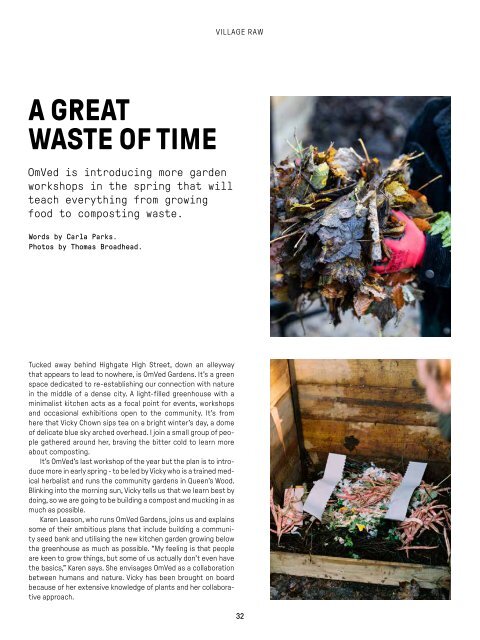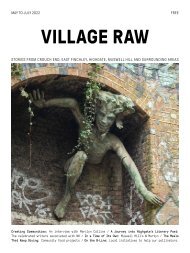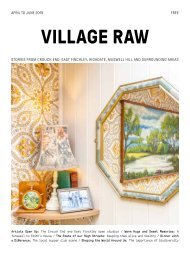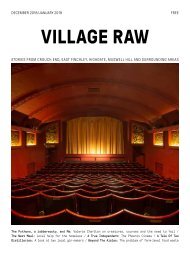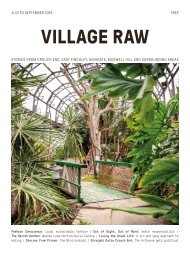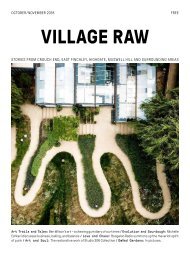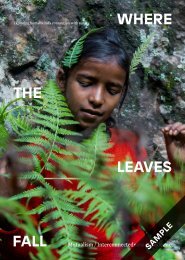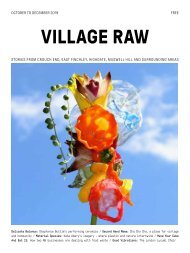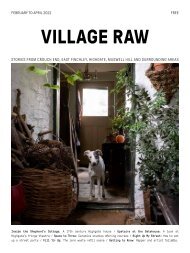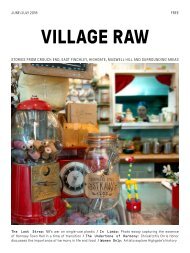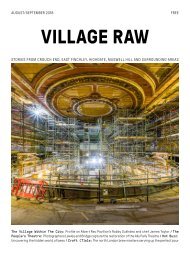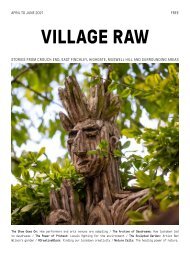Village Raw - ISSUE 9
Village Raw is a magazine that explores cultural stories from Crouch End, East Finchley, Highgate, Muswell Hill and the surrounding areas. The magazine is created by the community, for the community. If you like this issue you can support the project through a subscription or donation. See the links below. The ninth issue of Village Raw magazine includes: DOUBLE TAKE - Noma Bar - the illusionary storyteller. SOUNDS FROM THE CITY, SOUNDS FROM THE SEA - Singer-songwriter Austel on her musical journey. MR TOMMY HILL KNOWS - A new project from the artist previously known as WILLIAM. THE COLLODION WAY - John Hoare and his 19th century collodion photographic portraits. WITH. NOT FOR. - Wave Cafe – pushing boundaries and changing attitudes. BRIGHT ORANGE TILES - Revisiting Hornsey Town Hall to see how the restoration is progressing. WHERE THERE’S A WILL, THERE’S A WAY - Planting trees for the future. PLANT POWER - The healing power of plants with Handmade Apothecary. A GREAT WASTE OF TIME - Creating a compost lasagne. THE NORTH LONDON CHEESE HUNT - Meeting the local cheesemongers and producers. AND MORE…
Village Raw is a magazine that explores cultural stories from Crouch End, East Finchley, Highgate, Muswell Hill and the surrounding areas. The magazine is created by the community, for the community. If you like this issue you can support the project through a subscription or donation. See the links below. The ninth issue of Village Raw magazine includes:
DOUBLE TAKE - Noma Bar - the illusionary storyteller.
SOUNDS FROM THE CITY, SOUNDS FROM THE SEA - Singer-songwriter Austel on her musical journey.
MR TOMMY HILL KNOWS - A new project from the artist previously known as WILLIAM.
THE COLLODION WAY - John Hoare and his 19th century collodion photographic portraits.
WITH. NOT FOR. - Wave Cafe – pushing boundaries and changing attitudes.
BRIGHT ORANGE TILES - Revisiting Hornsey Town Hall to see how the restoration is progressing.
WHERE THERE’S A WILL, THERE’S A WAY - Planting trees for the future.
PLANT POWER - The healing power of plants with Handmade Apothecary.
A GREAT WASTE OF TIME - Creating a compost lasagne.
THE NORTH LONDON CHEESE HUNT - Meeting the local cheesemongers and producers.
AND MORE…
Create successful ePaper yourself
Turn your PDF publications into a flip-book with our unique Google optimized e-Paper software.
VILLAGE RAW<br />
PARTNER CONTENT<br />
A GREAT<br />
WASTE OF TIME<br />
OmVed is introducing more garden<br />
workshops in the spring that will<br />
teach everything from growing<br />
food to composting waste.<br />
Words by Carla Parks.<br />
Photos by Thomas Broadhead.<br />
Tucked away behind Highgate High Street, down an alleyway<br />
that appears to lead to nowhere, is OmVed Gardens. It’s a green<br />
space dedicated to re-establishing our connection with nature<br />
in the middle of a dense city. A light-filled greenhouse with a<br />
minimalist kitchen acts as a focal point for events, workshops<br />
and occasional exhibitions open to the community. It’s from<br />
here that Vicky Chown sips tea on a bright winter’s day, a dome<br />
of delicate blue sky arched overhead. I join a small group of people<br />
gathered around her, braving the bitter cold to learn more<br />
about composting.<br />
It’s OmVed’s last workshop of the year but the plan is to introduce<br />
more in early spring - to be led by Vicky who is a trained medical<br />
herbalist and runs the community gardens in Queen’s Wood.<br />
Blinking into the morning sun, Vicky tells us that we learn best by<br />
doing, so we are going to be building a compost and mucking in as<br />
much as possible.<br />
Karen Leason, who runs OmVed Gardens, joins us and explains<br />
some of their ambitious plans that include building a community<br />
seed bank and utilising the new kitchen garden growing below<br />
the greenhouse as much as possible. “My feeling is that people<br />
are keen to grow things, but some of us actually don’t even have<br />
the basics,” Karen says. She envisages OmVed as a collaboration<br />
between humans and nature. Vicky has been brought on board<br />
because of her extensive knowledge of plants and her collaborative<br />
approach.<br />
32<br />
Vicky says that the focus of the workshops will be on learning<br />
about where our food comes from, based on the seasons. One<br />
aim is to grow a variety of crops, so there will be an emphasis<br />
on slightly more unusual UK-based plants and keeping a regular<br />
diary to record how well certain plants respond. “We want people<br />
to learn the process of gardening, from composting to sowing<br />
seeds, to harvesting and saving seeds - and to just get everyone<br />
to do as much food growing as they can,” she explains.<br />
Composting, Vicky continues, has big benefits that include<br />
knowing your waste will not be going to landfill, as well as providing<br />
a nourishing environment for plants to grow. “All the scraps<br />
are going into the garden to be composted and put into your<br />
plants again. You can then enjoy them as flowers, vegetables, a<br />
healthy lawn or fruit trees. It’s a nice, closed loop cycle,” she says.<br />
There are different methods for composting but we’re learning<br />
about an open compost. The general rule is to have a ratio<br />
of one part green waste to two parts brown waste. Green waste<br />
adds nitrogen to the compost pile, encouraging microbe activity.<br />
Brown waste provides structure and is carbon rich. You alternate<br />
your green and brown layers, ensuring each one is about three to<br />
six inches deep, making a “compost lasagne”. You leave this for a<br />
few weeks and then turn or aerate the pile. In the summer you will<br />
need to do this more frequently than in the winter months.<br />
It’s surprisingly physical work since we need to move a huge<br />
pile of leaves. We add some of our green waste and that can in-<br />
33<br />
clude coffee grounds, nettles, grass clippings and raw kitchen<br />
waste. Our brown pile consists of old lavender twigs, cardboard<br />
and dry leaves. We also see a ‘bokashi’ compost, a Japanese<br />
method that uses fermentation and can be kept inside. After two<br />
hours we’re ready to call it a day, warming ourselves with another<br />
hot drink and admiring our compost pile.•<br />
VICKY’S DOS AND DON’TS FOR COMPOSTING:<br />
Do make the compost pile as big as possible.<br />
The bigger it is, the faster it will break down.<br />
Do add in a variety of mixed things as you would<br />
with your own diet.<br />
Don’t put perennial weeds in your compost pile.<br />
The weed roots will spread to your garden.<br />
Don’t put cooked food on an open-pile compost,<br />
but you can add cooked food to a bokashi system.<br />
OmVed will be running a series of workshops starting in the spring, including composting.<br />
Check the website for updates and sign up to their newsletter at: www.omvedgardens.com<br />
or follow: @omvedgardens on Instagram


